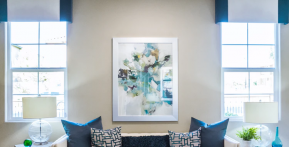
The technology, internet, and the digital age continue to help everyone stay connected from different parts of the world. It also opened various opportunities and showed methodologies that most of us are not aware of. One of them is E-design.
Most people and homeowners don't know much about what E-design is and how it can help them with their home interior dilemma, especially during these trying times when we need to limit our face-to-face interactions.
What is E-design?
E-design, as its name suggests, is a type of interior design service offered and provided entirely online. It is a simple and affordable alternative to traditional interior design. E-design services are performed virtually, cutting out the need for in-person travel and meeting. Thus anyone from different parts of the world can work with an E-designer without worrying about the location.
With E-design, interior design services can be completed without your designer having to visit your home. E-design is a perfect choice if you want a much simpler and laid-back process of interior home design services.
READ THIS: 5 Steps to Creating a Minimalist Home
How does E-design work?
You might be wondering how an e-designer will accomplish its job without setting foot in your home. Thanks to online shopping and electronic file-sharing, E-design services became possible. It allowed interior designers to work odd hours in their comfortable clothes, and clients don't have to deal with mystifying fees and get intimidated by home visits. It's more of a partnership than a top-down.
For E-design to work, clients just need to provide all the key dimensions, snapshots, and, if possible, a virtual tour. It also includes a wish list, examples of what the client likes, and, most especially, the client's budget.
The client and e-designer will talk about the timeframe of when the e-designer will send the client the floor plan and proposals. The proposal may include the rearrangement of furniture, changing layout, and brightening of the paint scheme.
A back-and-forth movement during the design stage is inevitable, which is why some designers set up a private Pinterest board. After all the decision-making, it is up to the client to manage the entire project. This makes it cost-effective. An online consult is much preferable if you're someone who doesn't like dealing with contractors and gathering materials.
Why is E-design growing?
Here are some reasons why e-design is growing and what makes it so great.
1. DIY - E-design provides clients with great opportunities. As a client, you will learn different things about the design process because it enables you to do stuff yourself, such as taking measurements and photos of your home. You will also be the one to manage and set up your space.
2. Affordable - As mentioned earlier, e-design is more cost-effective compared to traditional interior design. Since you'll be doing most of the leg work, you won't have to pay your designer for it.
3. Flat rate fees - More often, e-designers charge a flat rate fee for the design services. You don't have to worry about hidden fees at the end of the project. There's no need to pay for the designer's hourly rate, retainer, travel expenses, and the like.
4. No pressure timelines - When the designer completed the design, it's up to you to shop and set your space up. It means you don't have to worry about timelines. You can buy one item at a time or order everything at once. Unlike traditional interior design services, e-design allows you to make design purchases and decisions which significantly affect the project timeline as well as the project costs.
E-design is accessible, affordable, and has a fast turnaround. Aside from that, it also connects the gap between do-it-yourself and high-end interior designers. On your next home improvement project, try to give E-design a try.













